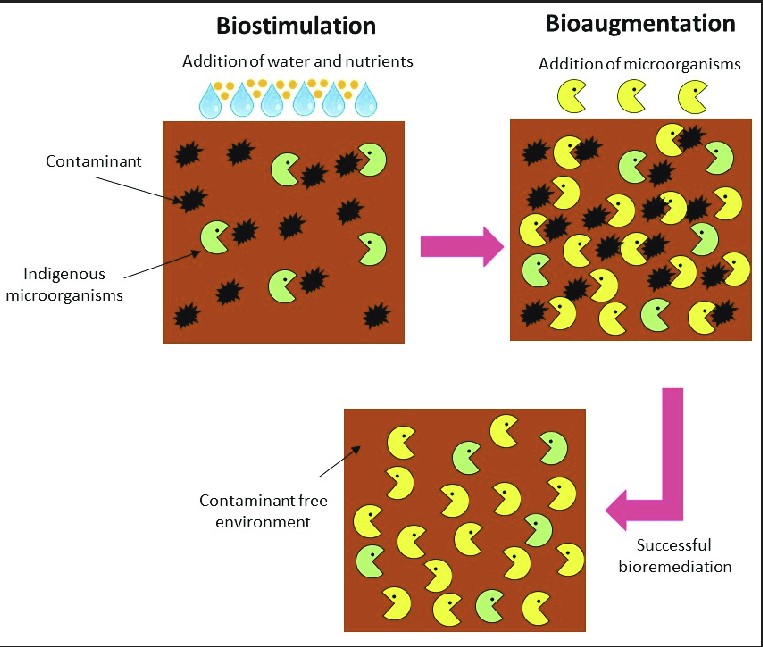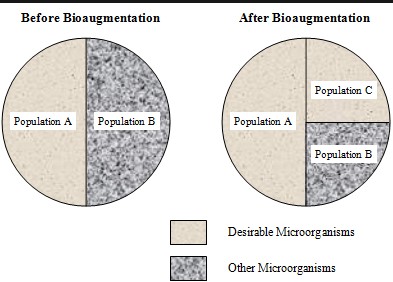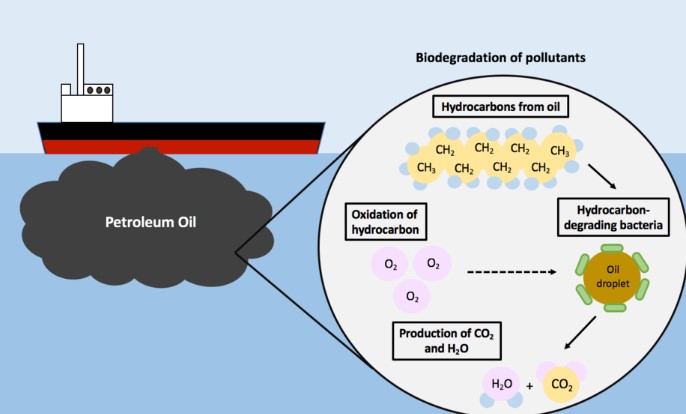Bioaugmentation and biostimulation represent two cornerstone strategies in the field of environmental remediation, each playing a pivotal role in addressing the persistent challenge of pollution. While they share a common goal of mitigating contaminants, their methodologies and applications differ significantly. This distinction not only underscores the complexity of environmental restoration efforts but also highlights the nuanced understanding required to deploy these technologies effectively.
Bioaugmentation involves the addition of cultured microorganisms into the environment to break down pollutants, whereas biostimulation enhances the existing bacterial population’s ability to degrade contaminants by providing additional nutrients or oxygen. Both approaches aim to accelerate the natural process of biodegradation, yet they operate under fundamentally different premises. Bioaugmentation introduces new microbial species to the ecosystem, while biostimulation optimizes conditions for indigenous microorganisms.
The selection between bioaugmentation and biostimulation hinges on numerous factors, including the type of pollutant, the environmental conditions, and the desired outcome of the remediation effort. Understanding these strategies’ mechanisms, benefits, and limitations is crucial for devising effective solutions to environmental challenges. This article explores the differences between bioaugmentation and biostimulation, offering insights into their applications, effectiveness, and impact on ecosystem restoration and sustainability.

Bioaugmentation Explained
Definition and Overview
Bioaugmentation is the process of adding selected, cultured microorganisms into the environment to accelerate the breakdown of pollutants. This method is particularly useful in settings where the natural microbial population is unable to degrade certain contaminants effectively.
Key Features
- Specificity: Targets specific pollutants with specially chosen microorganisms.
- Efficiency: Can significantly speed up the degradation process of contaminants.
- Versatility: Applicable in various settings, including soil, water, and wastewater treatment.
Applications and Examples
- Wastewater Treatment: Introduction of bacteria to break down organic matter in sewage.
- Soil Remediation: Use of fungi to degrade hydrocarbon pollutants in contaminated sites.
- Industrial Applications: Treatment of effluents from manufacturing processes to remove specific chemical contaminants.
Biostimulation Explained
Definition and Overview
Biostimulation involves modifying environmental conditions to enhance the natural capabilities of indigenous microorganisms for pollutant degradation. It’s a supportive approach, boosting the activity of existing microbial communities.
Key Features
- Enhancement: Optimizes environmental factors to support microbial growth.
- Broad-spectrum: Effective for a wide range of pollutants due to its non-specific nature.
- Sustainability: Leverages natural processes, minimizing the need for external inputs.
Applications and Examples
- Oil Spill Remediation: Nutrient addition to oil-contaminated beaches to stimulate microbial degradation of hydrocarbons.
- Agricultural Runoff: Adjustment of soil pH and nutrient levels to reduce pesticide and fertilizer contamination.
- Landfill Management: Aeration and moisture adjustment to enhance the decomposition of organic waste.
Comparative Analysis
Conceptual Differences
While bioaugmentation introduces specific microbes to tackle pollutants, biostimulation optimizes conditions for native microorganisms to flourish and degrade contaminants more effectively.
Basic Definitions Revisited
Bioaugmentation is about adding, biostimulation is about enhancing.
Primary Objectives
- Bioaugmentation: To introduce efficient degraders of specific pollutants.
- Biostimulation: To enable the existing microbial community to perform better.
Methodology and Approach
- Bioaugmentation: Direct addition of microbial cultures.
- Biostimulation: Adjustment of environmental conditions, like nutrients or oxygen levels.
Application Scope
Suitability in Various Environments
- Bioaugmentation: Best for specific, difficult-to-degrade contaminants.
- Biostimulation: Suitable for a broader range of pollutants, depending on existing microbial communities.
Types of Pollutants Treated
- Bioaugmentation: Specific organic and inorganic compounds.
- Biostimulation: Various pollutants, particularly organic waste and hydrocarbons.
Effectiveness and Efficiency
- Bioaugmentation: Highly effective for target pollutants; efficiency varies with conditions.
- Biostimulation: Effectiveness depends on the ability of indigenous microbes to adapt; generally more efficient for widespread contamination.
Technological Aspects
Implementation Techniques
- Bioaugmentation: Laboratory-grown cultures are introduced into the contaminated site.
- Biostimulation: Application of nutrients, oxygen, or other amendments to stimulate microbial growth.
Advances and Innovations
Technological advances have enhanced the precision and effectiveness of both strategies, from genetically engineered microbes for bioaugmentation to sophisticated monitoring tools for optimizing biostimulation conditions.
Challenges and Limitations
Both strategies face challenges, such as the unpredictability of microbial behavior in the environment and the complexity of contaminant mixtures.
Environmental Impact
Ecosystem Restoration
Both approaches aim to restore contaminated environments but through different means. Bioaugmentation adds new microbial players, while biostimulation empowers the existing ones.
Benefits to Biodiversity
- Bioaugmentation: Can introduce beneficial microbial diversity.
- Biostimulation: Supports the health and diversity of native microbial communities.
Long-term Sustainability
Biostimulation, by enhancing natural processes, often offers a more sustainable solution, though bioaugmentation can be more targeted and faster acting in certain cases.
Potential Risks
Unintended Consequences
- Bioaugmentation: Risk of disrupting local ecosystems with introduced species.
- Biostimulation: Overstimulation could lead to imbalances in microbial communities.
Mitigation Strategies
Careful planning, monitoring, and adaptation of treatment strategies are essential to minimize risks and maximize the benefits of both approaches.

Economic Perspectives
Cost Analysis
Bioaugmentation and biostimulation vary significantly in terms of initial investment and operational costs. Bioaugmentation’s upfront expenses include the cost of culturing specific microbes, which can be high depending on the complexity of the contaminants. Biostimulation, on the other hand, may involve lower initial costs, focusing on the addition of nutrients or amendments to the environment, which are generally less expensive than specialized microbial cultures.
Initial Investment
- Bioaugmentation: High due to specialized microbial cultures.
- Biostimulation: Relatively lower, with costs mainly associated with environmental amendments.
Long-term Savings
Both strategies offer long-term environmental and economic benefits, including reduced reliance on chemical treatments and potential savings from avoiding regulatory fines associated with contamination. Investing in these biological treatments can enhance an organization’s sustainability profile, contributing to long-term operational savings.
Market Trends
The global market for bioaugmentation and biostimulation is on the rise, driven by increasing environmental regulations and a growing awareness of sustainable remediation technologies. The demand for eco-friendly solutions is pushing the development and adoption of these biotechnologies across various sectors, including agriculture, wastewater treatment, and industrial manufacturing.
Demand and Supply Dynamics
The supply of bioremediation services is expanding, with numerous companies entering the market to meet the increasing demand for sustainable environmental cleanup solutions. This dynamic is fostering innovation and competition, leading to improved technologies and lower costs over time.
Future Growth Potential
The potential for growth in the bioaugmentation and biostimulation market is significant. As regulatory pressures increase and public awareness of environmental issues grows, these biological treatment methods are poised for further expansion and development.
Case Studies
Successful Implementations
Bioaugmentation Case Study
A notable example of successful bioaugmentation is the treatment of a contaminated industrial site where traditional cleanup methods had failed to reduce pollutant levels effectively. By introducing a specialized microbial consortia designed to degrade specific toxic compounds, the site saw a dramatic reduction in contaminant concentrations, meeting regulatory standards within months.
Biostimulation Case Study
An agricultural runoff site plagued with pesticide contamination underwent a biostimulation treatment, where strategic nutrient amendments enabled the native microbial population to degrade pollutants more efficiently. This approach not only restored the water quality but also improved the surrounding ecosystem’s health.
Comparative Success Rates
Comparing the success rates of bioaugmentation and biostimulation reveals that both strategies can be highly effective under the right conditions. The choice between them depends on specific site characteristics, types of contaminants, and environmental goals.
Analysis of Outcomes
Both strategies have shown positive outcomes in various contexts, from reducing hazardous pollutants to restoring natural habitats. Success often hinges on careful planning, monitoring, and adjustment of treatment protocols.
Lessons Learned
Key lessons include the importance of understanding site-specific conditions, the potential need for combining strategies, and the value of ongoing monitoring and adaptation to achieve the best outcomes.
Industry Insights
Expert Opinions
Industry experts emphasize the growing role of bioaugmentation and biostimulation in modern environmental management. They highlight the importance of these strategies in achieving sustainable remediation and the potential for technological advancements to enhance their effectiveness and applicability.
Quotes and Perspectives
“Bioaugmentation and biostimulation represent the future of environmental cleanup, combining efficiency with sustainability,” says a leading environmental scientist. These technologies not only address pollution but also contribute to the health of ecosystems, showcasing the power of leveraging natural processes for remediation.
Future Directions
Future directions include the development of more targeted microbial strains, improved delivery systems for biostimulation agents, and the integration of digital technologies for real-time monitoring and control of bioremediation processes.
Regulatory Framework
Global Standards
The regulatory landscape for bioaugmentation and biostimulation is evolving, with several countries establishing guidelines to ensure the safe and effective use of these technologies. Global standards focus on minimizing risks to human health and the environment while maximizing the benefits of bioremediation.
Compliance and Monitoring
Compliance with regulatory standards is crucial for the successful implementation of bioaugmentation and biostimulation projects. Monitoring protocols are typically established to track treatment progress, evaluate effectiveness, and ensure that environmental restoration goals are met without adverse side effects.

Frequently Asked Questions
What is bioaugmentation?
Bioaugmentation is a remediation technology that involves introducing specific, cultured microorganisms into an environment to accelerate the degradation of pollutants. This approach is particularly effective for treating environments contaminated with specific hazardous compounds that native microbial populations cannot readily degrade.
How does biostimulation work?
Biostimulation works by enhancing the environmental conditions to boost the activity and growth of indigenous microorganisms. This is often achieved by adding nutrients, oxygen, or other substances that stimulate the natural biodegradation processes, making it a versatile approach for a wide range of pollutants.
When is bioaugmentation preferred over biostimulation?
Bioaugmentation is preferred over biostimulation when the existing microbial population is incapable of degrading the pollutant at a desired rate, or when the contaminant is of a specific nature that requires specialized microbes. It’s particularly useful for complex pollutants that are not readily biodegradable by the indigenous microbial community.
Can bioaugmentation and biostimulation be used together?
Yes, bioaugmentation and biostimulation can be used in conjunction to enhance the biodegradation process. Combining both approaches can optimize the degradation of pollutants by introducing efficient microbial strains while also creating favorable conditions for their growth and activity.
Conclusion
The nuanced differences between bioaugmentation and biostimulation underscore the complexity and versatility of strategies available for environmental remediation. By leveraging the unique capabilities of microorganisms, both approaches offer valuable tools for tackling pollution, each with its distinct mechanisms, applications, and potential impacts on ecosystems. The choice between them depends on various factors, including the nature of the pollutant and the specific environmental context.
As we continue to face the challenges of environmental pollution, the importance of such remediation technologies cannot be overstated. Bioaugmentation and biostimulation not only represent significant advances in our ability to restore contaminated environments but also reflect a broader commitment to sustainability and the preservation of natural ecosystems. Through continued research and application, these strategies will remain pivotal in our efforts to achieve a cleaner, healthier planet.

